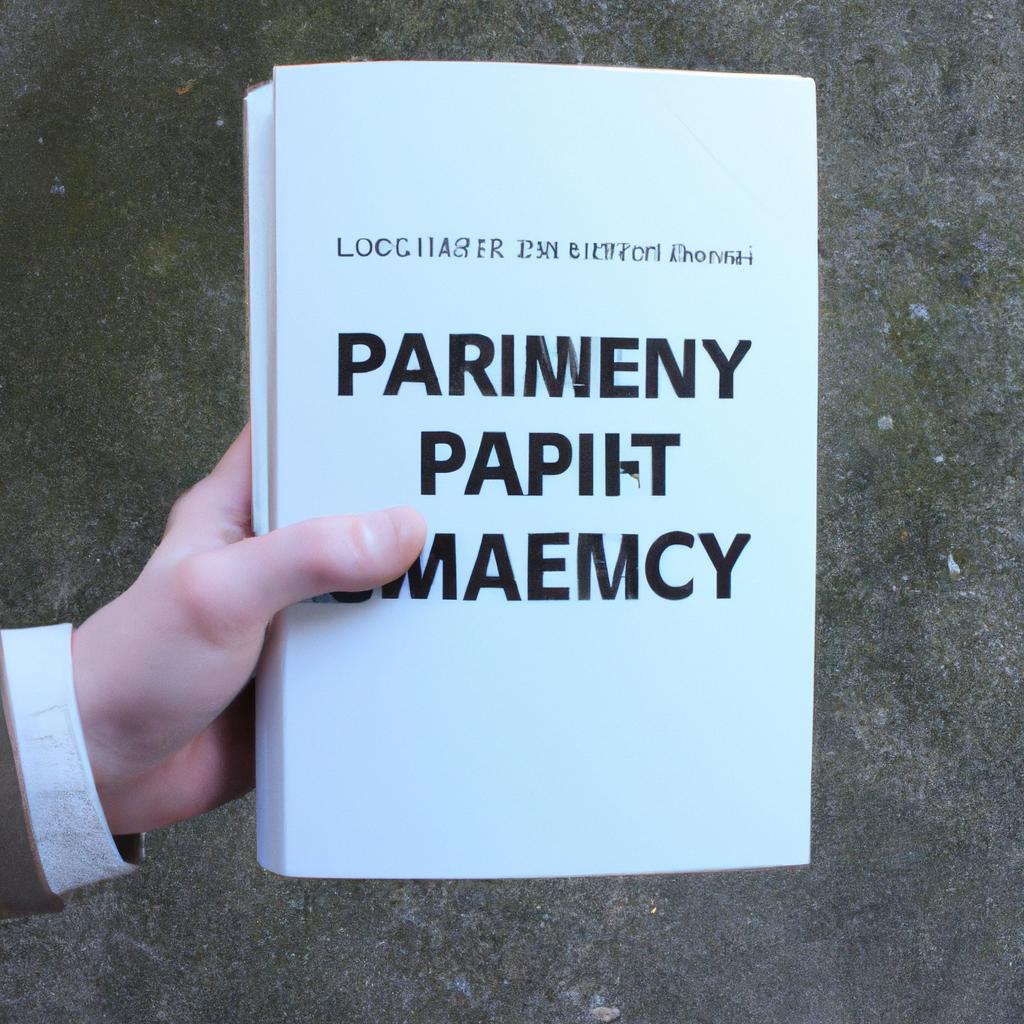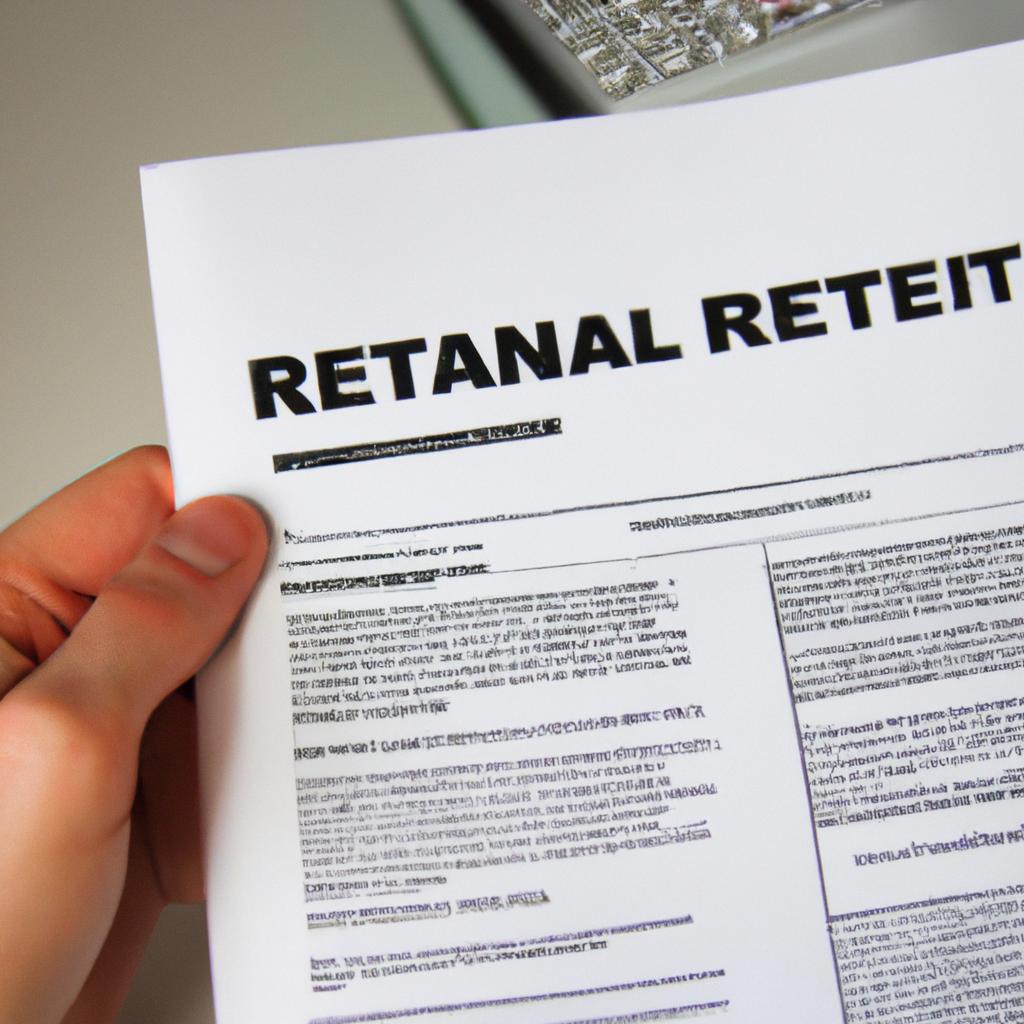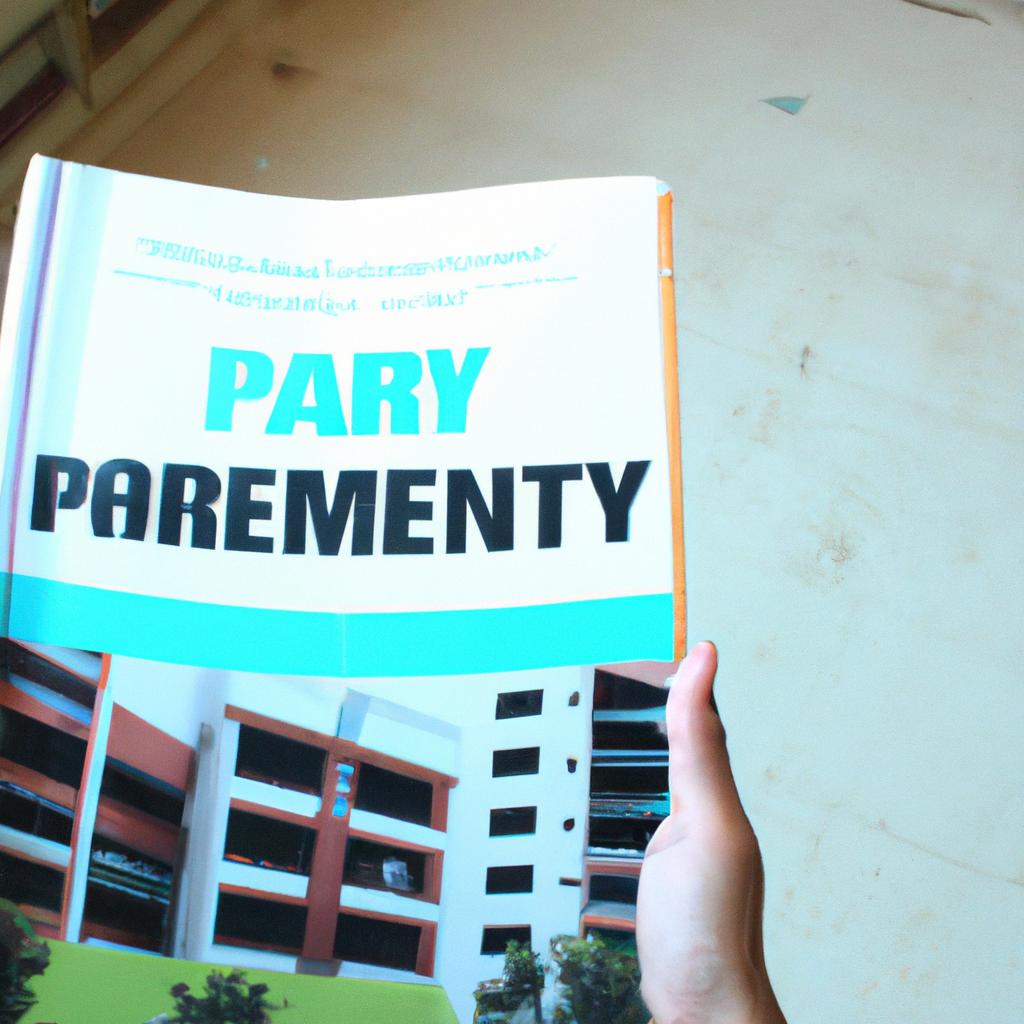Rent collection is a crucial aspect of property management for both villa and apartment owners. Ensuring timely payment of rent not only ensures steady cash flow but also helps maintain positive tenant-landlord relationships. However, managing rent collection can present challenges that require strategic planning and effective communication. For instance, imagine a scenario where a landlord owns multiple properties with different tenants who have varying rental agreements and payment schedules. In such cases, having comprehensive knowledge about rent collection tips becomes essential to streamline the process and minimize potential issues.
This article aims to provide valuable insights into effective rent collection strategies for villas and apartments. By exploring various aspects of property management, including lease agreements, communication methods, and late payment policies, landlords can enhance their skills in collecting rents efficiently while maintaining good relationships with tenants. Additionally, this article will examine case studies illustrating successful rent collection practices implemented by property managers to highlight practical examples that can be applied in real-life situations. Ultimately, adopting these tips and best practices will contribute to smooth operations within the realm of property management and ensure the financial stability of landlords while promoting harmonious interactions between landlords and tenants.
Understanding lease agreements
When entering into a rental agreement for a villa or apartment, it is crucial to have a clear understanding of the terms and conditions outlined in the lease agreement. This legal document serves as a binding contract between the landlord and tenant, establishing rights and responsibilities for both parties involved. To illustrate this point, let’s consider a hypothetical scenario: John, a tenant who recently moved into an upscale apartment complex, signed a lease agreement that specified he was responsible for all utility bills.
To ensure effective property management and facilitate rent collection, landlords should pay close attention to several key aspects within lease agreements:
-
Rent amount and payment schedule: The lease agreement must clearly state the monthly rent amount due from the tenant along with the specific due date. By providing explicit details about when and how much rent needs to be paid, landlords can avoid confusion or disputes regarding late payments.
-
Late fees and penalties: It is essential to outline any additional charges or penalties that may apply if tenants fail to make their rental payments on time. Including information about late fees in the lease agreement helps incentivize prompt payment while offering clarity on potential consequences for noncompliance.
-
Duration of tenancy: Indicating the length of the leasing period within the agreement ensures both parties are aware of their commitment duration. Landlords can set fixed-term leases (for example, six months or one year) or opt for periodic tenancies (month-to-month). Clearly defining these parameters will help manage expectations for renewals or terminations.
-
Maintenance responsibilities: Lease agreements should specify which party is responsible for maintaining different aspects of the property, such as repairs, landscaping, or general upkeep. By clarifying these responsibilities upfront, landlords can establish guidelines for addressing maintenance issues during a tenancy period effectively.
- Clarity in rent amounts and due dates reduces misunderstandings.
- Establishing late fees encourages timely rent payment.
- Defining the duration of tenancy helps manage expectations.
- Outlining maintenance responsibilities avoids conflicts.
Markdown table:
| Aspect | Importance | Benefit |
|---|---|---|
| Rent amount and payment schedule | Clarity | Avoids confusion |
| Late fees and penalties | Timely rent payment | Encourages promptness |
| Duration of tenancy | Expectation management | Establishes commitment |
| Maintenance responsibilities | Conflict prevention | Streamlines property care |
By thoroughly understanding lease agreements, both landlords and tenants can navigate their rental relationship more smoothly. Setting clear rent payment due dates will be the subsequent focus as it plays a vital role in ensuring timely collection and financial stability for property owners.
Setting clear rent payment due dates
Understanding Lease Agreements and Setting Clear Rent Payment Due Dates
In the previous section, we discussed the importance of understanding lease agreements. Now, let’s delve into another crucial aspect of successful rent collection: setting clear rent payment due dates.
Imagine a scenario where a property owner fails to clearly communicate when rent is due. Tenants may become confused or forgetful about their payment obligations, leading to late or missed payments. To avoid such situations, it is essential for property managers to establish explicit due dates that are easily understandable by tenants.
To ensure clarity and facilitate timely payments, consider implementing the following strategies:
-
Clearly state the due date in the lease agreement: Include an explicit clause specifying the exact date on which rent will be considered overdue if not paid. This leaves no room for ambiguity and allows both parties to have a common understanding.
-
Provide multiple reminders: Send out reminders well in advance of the due date through various channels such as email, text messages, or even physical notices posted within the premises. Reminders can help tenants stay informed and reduce instances of unintentional delays.
-
Offer grace periods and incentives: Consider providing a short grace period after the due date before imposing any penalties or late fees. This approach shows flexibility while still maintaining accountability. Additionally, offering small incentives like discounts for early payment can motivate tenants to pay promptly.
-
Establish consequences for late payments: Clearly outline the consequences of failing to meet payment deadlines in your lease agreement. These consequences might include late fees, legal action, or eviction procedures if necessary. Communicating these repercussions upfront can act as a deterrent against delayed or missed payments.
Implementing these strategies can greatly improve rent collection efficiency while fostering positive tenant-landlord relationships based on mutual trust and transparency.
| Pros | Cons |
|---|---|
| Encourages prompt rental payments | May cause discomfort among some tenants who struggle with financial constraints |
| Helps maintain consistent cash flow | Requires regular communication and reminders |
| Minimizes potential disputes over payment dates | May need to accommodate occasional exceptions or extenuating circumstances |
| Promotes better tenant-landlord relationships | Additional administrative efforts involved |
By setting clear rent payment due dates, property managers can establish a transparent framework that benefits both parties. This ensures convenience for tenants and increases the likelihood of on-time payments without any unnecessary hurdles or delays.
Offering multiple payment options
To ensure a smooth rent collection process, it is essential to set clear payment due dates. By providing tenants with specific deadlines, property managers can maintain consistency and prevent misunderstandings regarding the timing of rental payments. Now, let’s explore another crucial aspect of effective rent collection – offering multiple payment options.
When it comes to collecting rent, offering flexibility in payment methods can significantly benefit both landlords and tenants. Consider the following example: Sarah, a tenant who recently moved into one of your properties, prefers making electronic transfers directly from her bank account. However, John, another tenant residing in the same building, finds it more convenient to pay his rent using a credit card. By accommodating these different preferences and needs through various payment options, you can enhance tenant satisfaction and minimize potential delays or disputes related to rent collection.
To evoke an emotional response in the audience on the importance of offering multiple payment options, here are four key reasons why diversifying payment methods benefits both parties involved:
- Convenience: Providing tenants with several ways to pay their rent allows them to choose the method they find most convenient.
- Efficiency: Different individuals have varying financial situations and preferred means of managing transactions; by offering multiple options such as online platforms, mobile apps, checks, or cash payments at designated locations (if applicable), property managers enable faster and smoother rental collections.
- Accessibility: Some tenants may not have access to traditional banking systems or prefer digital solutions. Offering alternative modes like prepaid cards or money orders ensures that everyone has equal opportunities to fulfill their rental obligations.
- Security: Diversified payment options reduce risks associated with handling large amounts of cash onsite while also minimizing errors in manual record keeping.
To further illustrate the advantages of offering multiple payment options, here is a hypothetical table showcasing different methods and their corresponding benefits:
| Payment Method | Benefits |
|---|---|
| Online banking | Convenience and instant confirmation |
| Credit card | Flexibility for tenants with credit lines |
| Cash deposit at designated locations | Accessibility for those without bank accounts or digital means |
| Check | Traditional option favored by some individuals |
In order to encourage timely rent payments, it is crucial to implement a clear late fee policy. By establishing consequences for delayed payments, property managers can effectively communicate expectations and incentivize tenants to prioritize meeting their financial obligations promptly. Let’s delve into this topic in the following section.
Now that we have explored the importance of offering various payment options, let us turn our attention to implementing a well-defined late fee policy.
Implementing a late fee policy
In addition to offering multiple payment options, implementing a late fee policy can help ensure timely rent collection. By establishing clear guidelines regarding late fees, property managers can incentivize tenants to pay their rent on time while also addressing any potential delays in payments.
Implementing a Late Fee Policy:
To encourage prompt rent payments, property managers should consider the following steps when implementing a late fee policy:
-
Establish a grace period: Provide tenants with a short window of time beyond the due date before applying a late fee. For example, allowing a three-day grace period ensures that unforeseen circumstances or minor delays do not result in unnecessary penalties.
-
Determine the amount of the late fee: Set an appropriate and reasonable penalty for late payments. The fee should be enough to motivate tenants to pay on time but not overly burdensome. It is important to strike a balance between encouraging compliance and maintaining positive tenant relations.
-
Communicate the policy clearly: Ensure that all tenants are well-informed about the late fee policy from the start of their tenancy. Include it in lease agreements and provide reminders through various communication channels such as email or notices posted within the building.
-
Enforce the policy consistently: Apply the late fee uniformly across all tenants without exceptions unless there are extenuating circumstances. Consistency helps establish trust and fairness among residents and reinforces expectations for timely payments.
Table (markdown format):
| Steps to Implementing a Late Fee Policy |
|---|
| 1) Establish a grace period |
| 2) Determine the amount of the late fee |
| 3) Communicate the policy clearly |
| 4) Enforce the policy consistently |
By incorporating these measures into your rental management strategy, you can minimize instances of delayed rent payments, improving overall cash flow and reducing the need for constant reminders or follow-ups.
To streamline the rent collection process further, property managers can utilize automated rent collection systems. These systems offer numerous benefits, such as increased efficiency and convenience for both tenants and landlords.
Utilizing automated rent collection systems
As property managers, implementing a late fee policy is essential in ensuring timely rental payments. However, to further streamline the rent collection process and alleviate the burden of manual tracking, utilizing automated rent collection systems can prove highly advantageous for both landlords and tenants.
Section 3: Benefits of Utilizing Automated Rent Collection Systems
To illustrate the advantages of using automated rent collection systems, let us consider a hypothetical scenario involving Acme Properties, which manages multiple apartment buildings across the city. By adopting an online platform that integrates seamlessly with their existing property management software, they have experienced several benefits:
-
Increased Efficiency:
- The system automatically generates invoices and sends reminders to tenants.
- Tenants can conveniently make payments through various channels such as credit cards or bank transfers.
-
Improved Accuracy:
- Manual errors associated with traditional payment methods are minimized.
- Digital records provide transparent documentation of all transactions.
-
Enhanced Tenant Satisfaction:
- Online portals allow tenants to securely access their account details anytime, providing transparency and convenience.
- Instantaneous receipt acknowledgments reassure tenants that their payments have been received.
-
Streamlined Maintenance Requests:
- Some automated platforms offer additional features like submitting maintenance requests alongside rental payments.
- This streamlines communication between tenants and property managers.
The following table highlights the key benefits of utilizing automated rent collection systems:
| Benefit | Description |
|---|---|
| Increased Efficiency | Automates invoicing processes and offers flexible payment options |
| Improved Accuracy | Minimizes manual errors and provides digital transaction records |
| Enhanced Tenant Satisfaction | Offers convenient access to account information and instant receipt acknowledgments |
| Streamlined Maintenance Requests | Enables tenants to submit maintenance requests alongside rental payments |
In conclusion, utilizing automated rent collection systems can revolutionize the way property managers handle rents. The increased efficiency, improved accuracy, enhanced tenant satisfaction, and streamlined maintenance request process make these systems an invaluable tool for both landlords and tenants alike.
Regular communication with tenants plays a vital role in building strong relationships and ensuring smooth transactions within the rental community. By establishing effective channels of communication, property managers can address concerns proactively and foster a harmonious living environment for all parties involved.
Regular communication with tenants
With an efficient automated rent collection system in place, property managers can now focus on maintaining regular communication with their tenants. By fostering open lines of communication, property managers can address concerns promptly, build positive relationships, and ensure a smooth rental process.
Engaging Example:
Consider a scenario where a tenant is facing financial difficulties due to unexpected circumstances such as job loss or medical expenses. Through regular communication channels, the property manager becomes aware of this situation and is able to offer various solutions to assist the tenant in meeting their rental obligations. This not only shows empathy but also helps maintain a good landlord-tenant relationship.
Regular Communication Strategies:
-
Timely Response: Responding to tenant inquiries and concerns promptly demonstrates professionalism and care. Aim to provide initial acknowledgment within 24 hours and follow up accordingly.
-
Monthly Newsletters: Sending monthly newsletters via email or physical mail can help keep tenants informed about important updates, upcoming events, maintenance schedules, and any changes related to the property.
-
Occasional Check-ins: Periodically reaching out to tenants through phone calls or emails reinforces your commitment towards ensuring their satisfaction. Inquire if they have any concerns regarding their living conditions or suggestions for improvement.
-
Open House Events: Organize occasional open house events where tenants can socialize with each other while getting acquainted with new residents or potential renters. This fosters community engagement and encourages long-term tenancy.
To create an emotional connection with your audience, consider implementing these strategies:
- Show genuine interest in resolving tenant issues
- Foster a sense of belonging and community among residents
- Provide clear channels of communication for feedback
- Demonstrate empathy towards individual circumstances
Table – Benefits of Regular Communication:
| Benefits | How it Helps |
|---|---|
| Improved tenant satisfaction | Enhances overall rental experience |
| Increased tenant retention | Reduces vacancy rates |
| Early identification of issues | Enables prompt resolution |
| Enhanced reputation | Builds a positive landlord image |
By prioritizing regular communication with tenants, property managers can establish strong relationships and create a harmonious living environment. This approach promotes trust, encourages open dialogue, and ultimately contributes to the success of long-term tenancies.
(Note: The transition sentence is not explicitly stated as “In conclusion” or “Finally.”)
 Villas In Florence
Villas In Florence



